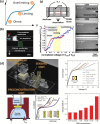Electrokinetic ion transport in nanofluidics and membranes with applications in bioanalysis and beyond
- PMID: 29713395
- PMCID: PMC5897123
- DOI: 10.1063/1.5022789
Electrokinetic ion transport in nanofluidics and membranes with applications in bioanalysis and beyond
Abstract
Electrokinetic transport of ions between electrolyte solutions and ion permselective solid media governs a variety of applications, such as molecular separation, biological detection, and bioelectronics. These applications rely on a unique class of materials and devices to interface the ionic and electronic systems. The devices built on ion permselective materials or micro-/nanofluidic channels are arranged to work with aqueous environments capable of either manipulating charged species through applied electric fields or transducing biological responses into electronic signals. In this review, we focus on recent advances in the application of electrokinetic ion transport using nanofluidic and membrane technologies. We start with an introduction into the theoretical basis of ion transport kinetics and their analogy to the charge transport in electronic systems. We continue with discussions of the materials and nanofabrication technologies developed to create ion permselective membranes and nanofluidic devices. Accomplishments from various applications are highlighted, including biosensing, molecular separation, energy conversion, and bio-electronic interfaces. We also briefly outline potential applications and challenges in this field.
Figures






Similar articles
-
Asymmetric ion transport through ion-channel-mimetic solid-state nanopores.Acc Chem Res. 2013 Dec 17;46(12):2834-46. doi: 10.1021/ar400024p. Epub 2013 May 28. Acc Chem Res. 2013. PMID: 23713693 Review.
-
Two-Dimensional Nanofluidic Membranes toward Harvesting Salinity Gradient Power.Acc Chem Res. 2021 Nov 16;54(22):4154-4165. doi: 10.1021/acs.accounts.1c00431. Epub 2021 Oct 31. Acc Chem Res. 2021. PMID: 34719227
-
Ion transport in nanofluidics under external fields.Chem Soc Rev. 2024 Mar 18;53(6):2972-3001. doi: 10.1039/d3cs00367a. Chem Soc Rev. 2024. PMID: 38345093 Review.
-
High-performance bioanalysis based on ion concentration polarization of micro-/nanofluidic devices.Anal Bioanal Chem. 2019 Jul;411(18):4007-4016. doi: 10.1007/s00216-019-01756-8. Epub 2019 Apr 10. Anal Bioanal Chem. 2019. PMID: 30972474 Review.
-
Ionic conductance of nanopores in microscale analysis systems: where microfluidics meets nanofluidics.J Sep Sci. 2007 Jul;30(10):1398-419. doi: 10.1002/jssc.200600427. J Sep Sci. 2007. PMID: 17623420
References
-
- Van Roosbroeck W. V., Bell Syst. Tech. J. 29, 560 (1950).10.1002/j.1538-7305.1950.tb03653.x - DOI
-
- Reiss H., J. Chem. Phys. 21, 1209 (1953).10.1063/1.1699165 - DOI
-
- Shockley W., Nobel Lectures, Physics 1942–1962 ( Elsevier Publishing, Amsterdam, 1964), Vol. 344.
-
- Manzanares J., Murphy W., Mafe S., and Reiss H., J. Phys. Chem. 97, 8524 (1993).10.1021/j100134a023 - DOI
Publication types
LinkOut - more resources
Full Text Sources
Other Literature Sources
